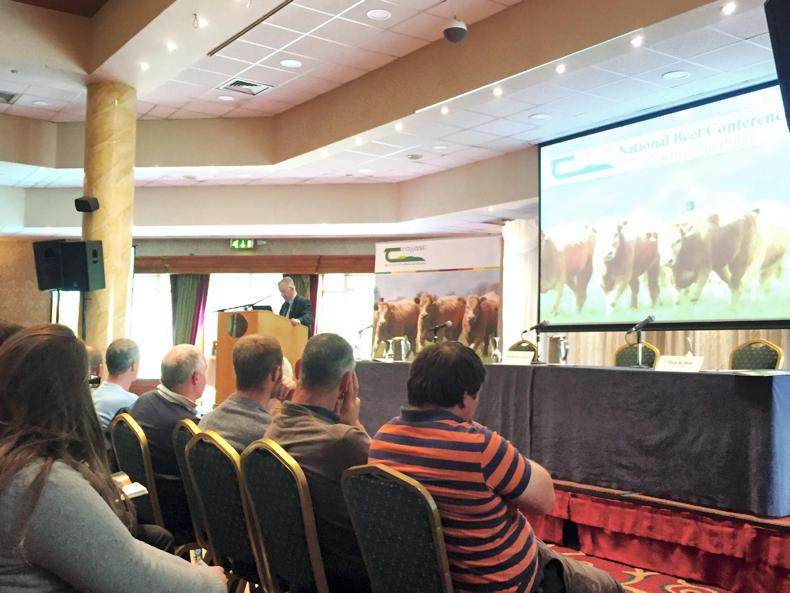Dairy-calf-to-beef systems can deliver a farmer over €200/head profit, according to new findings unveiled at the Teagasc National Beef Conference.
Session one of the conference, which was held in Athlone on Tuesday, focused on dairy beef systems.
Teagasc researcher, Dr Robert Prendiville told the packed auditorium that there would be 840,000 dairy calves potentially available for beef production annually in the coming years; 41% of these being pure dairy breeds and 43% being Angus- or Hereford-sired.
Profitablility
An economic analysis had been carried out on various production systems, all of which involved rearing a spring-born calf. These systems involved both heifers and bullocks, early-maturing cross (EMX) and pure Holstein animals, with slaughter ages ranging from 20 to 28 months.
Based on a €100 and €270 calf price for Holstein and EMX bulls respectively, a €3.80/kg beef price and a €255 finishing concentrate price, the 21-month EMX bullock system worked out as the most profitable.
This involved slaughtering animals prior to a second winter, with 63% of the animal’s post-weaning diet coming in the form of grazed grass. Half a tonne of concentrate was required for the system and target carcase weight was 280kg.
On a 40ha farm, slaughtering 120 animals annually, a whole-farm net profit of €26,112, or €218 per head could be achieved. At a beef price of €4.00, this margin figure increased to €273/head. Dr Prendiville also demonstrated how a €20 increase in calf price reduced net margin by 12% in calf-to-beef systems.
These figures included no land, or labour charge.
While the target is to achieve breed and QAS bonuses, the figures are based on a realistic, albeit small, number of animals falling outside the relevant specifications and thus not receiving the bonuses.
Prendiville also commented that while the EMX bullock system saw the vast majority of animals hitting specification, some of the other systems operated on targets closer to minimum specifications and were thus at more risk of price penalties.
Read more
Full coverage: Teagasc National Beef Conference
Dairy-calf-to-beef systems can deliver a farmer over €200/head profit, according to new findings unveiled at the Teagasc National Beef Conference.
Session one of the conference, which was held in Athlone on Tuesday, focused on dairy beef systems.
Teagasc researcher, Dr Robert Prendiville told the packed auditorium that there would be 840,000 dairy calves potentially available for beef production annually in the coming years; 41% of these being pure dairy breeds and 43% being Angus- or Hereford-sired.
Profitablility
An economic analysis had been carried out on various production systems, all of which involved rearing a spring-born calf. These systems involved both heifers and bullocks, early-maturing cross (EMX) and pure Holstein animals, with slaughter ages ranging from 20 to 28 months.
Based on a €100 and €270 calf price for Holstein and EMX bulls respectively, a €3.80/kg beef price and a €255 finishing concentrate price, the 21-month EMX bullock system worked out as the most profitable.
This involved slaughtering animals prior to a second winter, with 63% of the animal’s post-weaning diet coming in the form of grazed grass. Half a tonne of concentrate was required for the system and target carcase weight was 280kg.
On a 40ha farm, slaughtering 120 animals annually, a whole-farm net profit of €26,112, or €218 per head could be achieved. At a beef price of €4.00, this margin figure increased to €273/head. Dr Prendiville also demonstrated how a €20 increase in calf price reduced net margin by 12% in calf-to-beef systems.
These figures included no land, or labour charge.
While the target is to achieve breed and QAS bonuses, the figures are based on a realistic, albeit small, number of animals falling outside the relevant specifications and thus not receiving the bonuses.
Prendiville also commented that while the EMX bullock system saw the vast majority of animals hitting specification, some of the other systems operated on targets closer to minimum specifications and were thus at more risk of price penalties.
Read more
Full coverage: Teagasc National Beef Conference










SHARING OPTIONS